#best automation testing tutorial
Explore tagged Tumblr posts
Text
#tutorials#automation#tutorial academy#tutorials for beginners#india#best automation testing tutorial#automation testing for beginners#automation testing#online training#tutorial#testing
0 notes
Note
Hi!! I wanted to say that I loved reading about your journey of creating a personal website. I'm still unsure between Vercel and Netlify. I have a small question to ask. See, one of the reasons I want to make a website is to archive drawings and journal/sketchbook. Would you have any tips for creating an area on my website just for the diary/journal, which has tags, files for each entry, etc.?
Bello!

Really happy to hear about your interest in websites! I want everyone to make their own site so I don't have to log into social media and get instant tummyaches ♥
Vercel vs Netlify: I think I settled on Vercel for absolutely no reason whatsoever. I just made a site on Netlify, then tested on Vercel, and now I have like 5 websites on Vercel so I just kept using it LOL. I'm sure a more tech-savvy person would know the difference - I think they have certain integrations with specific programs.
Creating a diary or journal with tags:
There's a couple of different ways you can do that, with different levels of work needed.
you got me yapping again:
This sadgrl tutorial might be outdated and may or may not work, but explains the process better than I can.
Easiest: make a journal on Dreamwidth, or another blogging site (wordpress??) that allows easy tags and RSS feed, and embed that RSS feed onto your site.
This requires almost no HTML set-up, and the easiest to organize tags, but you don't truly have the data on your own site since it's just embedded.
When I snuck into a web design class at college, this was one of the methods that the professor used for a blog within a portfolio site LOL.
Shit like wordpress is what a LOT of ~professional~ sites do for their blog section. They code it separately from the main site haha. It's the most popular thing, but not necessarily the best. And wait til you read on what the CEO of wordpress has been having meltdowns about... he owns tumblr too!
It's made with a tutorial for Neocities if that's what you use.
Medium: Set up zonelets.
It will require some HTML and JS editing, but will help automate making headers/footers for each page of a blog.
I've never used it myself, but I see other people speak highly of it.
HARD FOR ME CUZ I'M A GORILLA: I believe a lot of professional web devs will slap your face with their coding cock until you use a static site generator (SSG) to make your site.
You will need some coding knowledge to set up the tagging system since it doesn't come with it enabled by default. But it's made explicitly to be an alternative to big Static Site Generators which are...
It requires some more intimidating knowledge, because it's a lot of scripts that turn files that are not HTML/CSS/JS into plain HTML.
Also you have to use the command line, and that doesn't come with buttons that tell you what you can do. You have to copy/paste all that shit or memorize the code to 'dev build astro' and it all looks silly.
I've used Eleventy, and now am using Astro. Other people use Hugo or Jekyll or some other stuff with crazy names like Glup Shitto. I hate all these sites cuz none of the words mean anything to me. This is a common theme for me and tech. I don't know what NODES or CONTENT or ISLANDS are!!!
I had the most success attempting to learn how to use a SSG by downloading a template and altering it with github + VScodium. Here's the template page for Astro. You click on a theme you like, and it takes you to its github page. (If you don't want to use evil Microsoft stuff sorry. Skip this entire section.) Follow the instructions on the page for "forking" the glup shitto. When it tells you to run commands, I run those commands through the terminal window in VScodium. These tutorials never tell you what these commands do cuz they assume you already know. Usually those commands automatically install the files you need onto your computer, and create the final files.
You can see my wip here for a "tag system" that SHOULD show members of a web listing haha but I don't know what I'm doing and I have a reading disorder AND don't know cumputer good.
THEORETICALLY this will be the simplest and easiest way to maintain tags and files, because after you set it up you just have to write the "content" of the blog page. And you don't have to set up the header/footer ever again. I see the vision, and potential, but I am not there yet when it takes me 5 hours a day to figure out what any of the words in the documentation mean and I don't want to ask an actual tech person cuz they will be like 'obviously just press the Blip on the Repository and then Suck My Ass in the command line".
(side note I haven't updated fujofans in like a year cuz I'm struggling with this part to make updating easier).
Con: the final HTML/CSS code is really ugly if it's "minified", and a lot of themes use """"""professional"""""" CSS libraries like Bootstrap and Tailwind that I honestly think are ugly cuz that's what every fuckin' tech website uses to style their pages and make them look Professional and Minimalist with stupid code like style="500-w dark-gray-balls D-cup-bra" on every single element. Even Toyhouse uses Bootstrap. Eugh!
But maybe you're smarter than me and can wrangle these things better!
That was really long. Woops. I hope you can slug through this wall of text and find something helpful. Feel free to email me if you have any more specific questions. I may or may not be helpful.
If someone else sees this and has better suggestions for making BLOGS, please chime in. I'm begging you.
64 notes
·
View notes
Note
Heyy, I’ve been reading your wonderful one piece works for a while — and I couldn’t stop wondering how are you actually doing those magnificent headers?
Like… hello? The great quality, with additional 3D-alike details I could catch by my eyes? I got only Ibis Paint X on mobile, since I’m only a young man that literally two months ago went on a life-time ‘adventure’ of living alone in a small apartment.
In short — I got no money to pay for additional graphics/drawing programs, not yet at least
Hello!
Thank you! I'm glad you enjoy my writing - I'm curious to know what's your favorite piece / part? Also I'm so happy you like my headers? Makes it feel worth it to spend time on them! :D
I have excellent news for you, I used a mix of Canva and Photopea. They're both FREE!


I'll be explaining the process for making these two kinda? The full tutorial is below the cut, to be courteous to the other folks, hope you don't mind?
Though I am hearing that Canva has given people some grief. But Photopea is just *chefs kiss*
If you've ever used photoshop, Photopea is essentially a free photoshop, and it even has the automation tools! An absolute lifesaver when you have multiple layers you want to export (but that's for larger projects not this)
I'm going to assume you have basic knowledge of layers in digital drawing programs for this. If anything isn't clear: ask me, I'll clarify!
//-------------------------------------------------
My General Process is:
Search for official art / images
bring it into canva / photopea
crop / arrange images to match the dimensions
select a thematic color that is associated with the character
separate the foreground from the background
mess around and test things until they work
//--------------------------------------------------
Given "Louder than Words" is the latest one I've made, I'll start with the process for it.

Dimensions: 3000 x 1055 px dpi: 96
//-------------------------------------------
Let's Get Crackin'
Alright let's grab some official art so we're not using any fanart without the artist's permission
I try to pick images that feel relevant enough to what I'm trying to make. For example: the image for the Matching banner shows the ASCE tattoo which is super important in that fic
2. Let's arrange them onto a banner where each individual image has the same/similar dimensions to the rest
That's probably part of why you like these. To a certain extent they have similar dimensions, so they have a uniformity that's pleasing to the eye! (It's not perfect because I threw perfectionism to the wind because this is tumblr not my portfolio) Tip: if you have 3 images and only 2 that have similar dimensions, and the 3rd one can't be cropped logically: but the one that's a different aspect ratio in the middle!

3. lets arrange them in such a way that the borders all feel like they're the same/equal width/thickness
you might find that you have to shrink some images for this, that's fine.
ALTERNATIVELY: if you're going with one image crop it so it's just the relevant info and it matches the dimensions (3000 x 1055 px)

We have our base! Now let's add some color, and direct the viewer's eye together!
4. pick out a color that you think matches your character / vibe - that color is going to be your background Given I'm making an Ace banner: orange is the color I'm going with
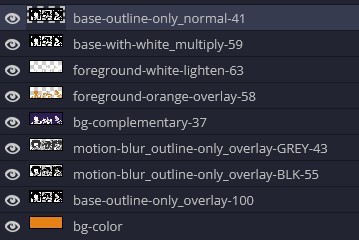
I went and named my layers for this lol. The numbers represent the opacity, and they aren't important. I just kept changing the opacity until I liked the way things looks. But here's the secret to the 3D feel:
Motionblur (+ moving it about)
Separating the foreground and background and dulling out the background.
I'm going to show you my process so you can see the effects, but first let's give you some quick skills:
//------------------------------------
SKILLS / THINGS I THINK ARE HELPFUL
//------- Select Similar
magic wand -> select something -> right-click -> select similar This works best when you have high contrast images (like manga panels that are black and white). You can select the black or the white areas. Depending on what works better for you. TIP! Invert selections with ctrl + i Say you know that you want to select everything but Ace's face in the second panel. Select his face with the magic wand then ctrl + i, and that's the only thing NOT selected

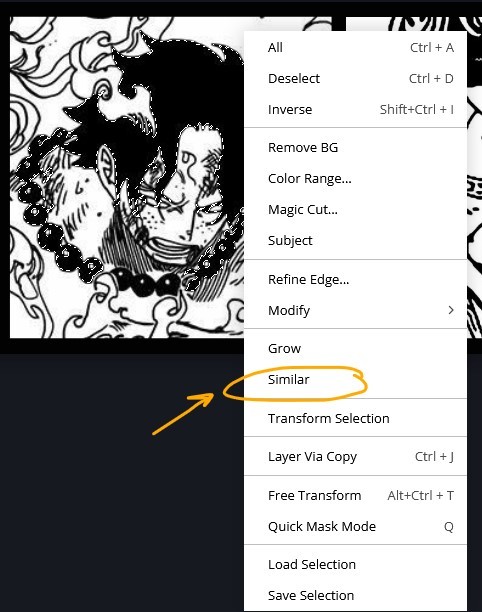


TIP!!!!!!!!!!!!!!! Please, please, please, duplicate your original image and work on the duplicate layer. This helps you SO much. !!!!!!!!!!!!!!!!! TIP! Check your selection tolerance! This could be why too little, or too much is being selected.

//------- The Move Tool
Shortcut key: v While the move tool is active, you can nudge the stuff on whatever layer with your arrow keys Shift + arrow key = 10 px move (generally)
//------- Layer Locking

1- Layer Blending Mode (see Overlay vs Multiply vs Normal) for how this can affect results) 2- Opacity: how see through it is / isn't 3- Lock Transparency (it's the little checker board) 4- Lock Layer (looks like a lock) 5- Lock icon that appears when anything on the layer has been locked More on 3 Lock Transparency: You can only paint on / modify what's on that layer. You CANNOT add anything to any area that is already transparent Here's a demo of what you can do with this power:
Here's the original Image - notice how it's just the lineart with a transparent background.



It's powerful: abuse it
//------- Overlay vs Multiply vs Normal

I think seeing this is the best way to visualize how different modes can affect the color.
//--------------------------------
Back to the Tutorial
!!I IMPORTANT NOTE !!
Please play around with the opacity slider to figure out what opacity works best for you on the multiple different layers we're about to make / work with. It's up to your own style to figure this out. Next: please feel free to not follow all of it. Add more layers, add less layers, take the base principles and go wild! :D
5. Separate the lineart from the background and save it as a new layer 6. Duplicate it and set it to overlay, or set it to overlay immediately

7. Duplicate that lineart layer twice and set the blending mode to overlay 8. lock transparency on the top one and change it to be a dark grey 9. Apply motion blur to both:
Main menu bar -> Filter -> Motion Blur I made it so that the grey layer was blurrier than the black layer


10. More them around a little to give it a "3D effect" as you called it.
It creates shadows under the lines - I was aiming for an effect similar to chromatic aberration (chromatic aberration is a valid way to add punch to your stuff too!)

So this is what things look like now - painful, but let's keep going
11. Duplicate the ORIGINAL / BASE lineart layer, that you DID not apply motion blur to -> set the blend mode to multiply (reduce opacity for it to actually take effect)

okay that's less painful here's what the layers look like right now:
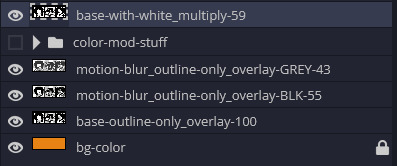
let's bring more focus to Ace's face, and push the background farther away:
12. Use the magic wand tool to quickly select large areas of the faces / focal area / foreground and the lasso tool to refine things
TIP! Hold shift + click -> add to selection Hold Alt + click -> subtract from selection
13. On a new layer with blending mode -> lighten, fill that selection to be white

If you look at it, you'll notice that it is ALREADY starting to draw our attention to his face, but the background is kinda aggressive, so let's dim that down
TIP! Right-click on the gradient tool to find the paint-bucket tool

TIP! Sample All Layers: Turning this option off makes it so that you only work with the content on THAT specific layer. Turning it on makes it so that it is working while taking all other layers into consideration.
14. ctrl + click on the "white foreground" layer to select the contents of that specific layer (pink thing is your mouse)
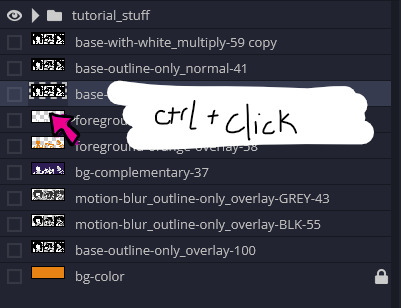
15. ctrl + i to invert selection and ON A NEW LAYER (layer mode -> multiply) fill that with a complementary color

16. I did one last thing where I took the original base (before we separated the lineart) and added it to the very top and played with the opacity to get something less in your face (layer blend mode was set to NORMAL)

And that's it!
More considerations that I take:
I want the banner to be "thin" or not square, so it doesn't take up too much screen real estate on people's devices
I don't want readers having to scroll too much to get to my writing (which is the whole point of the post, let's not waste their time making them look for things)
I want the banner content to be relevant enough?
ie: with Matching: I wanted the ASCE tattoo to be visible. With matching I wanted Ace to not look too happy in some of them.
I'm also trying to avoid spoilers, I hated getting things spoiled, so I'm trying to be careful that the images I pick don't spoil anything really.
Congrats on starting life on your own! I did that whole living by myself thing too! Tip: keep the pantry stocked with lentils, beans, pastas, baking essentials, rice. They really come in a clutch when you're hungry.
#photopea resources#photopea psd#tutorial#tutorials#tumblr banner#photoshop#photoshop tutorial#digital art#fuck adobe#adobe photoshop
39 notes
·
View notes
Text
ChannelBuilderAI Review: The Ultimate Automated Video Creation Solution
Introduction: Revolutionizing Content Creation
In today's fast-paced digital landscape, content creators face immense pressure to produce high-quality videos consistently. ChannelBuilderAI emerges as a game-changing solution, promising to streamline the entire video production process—from scripting to publishing. After extensive testing across multiple niches, I’m convinced this platform represents a significant leap forward in AI-powered content creation.

Core Features and Capabilities
ChannelBuilderAI stands out with its comprehensive feature set, addressing every stage of video production:
Advanced Script Generation: Crafts engaging, structured narratives tailored to your niche (e.g., horror, business, or education).
Human-Like Voiceovers: 78 voice options across 12 languages with emotional inflection (excitement, suspense, authority).
Smart Visual Composition: Auto-matches visuals to scripts with 42+ art styles (photorealistic, anime, etc.).
Built-in SEO Optimization: Generates high-CTR titles, descriptions, and thumbnails.
Multi-Platform Publishing: Formats videos for YouTube, TikTok, Instagram, and more.
Real-World Performance and Results
I tested ChannelBuilderAI across three channels, and the results were undeniable:
History Facts Channel:
Output increased from 2 to 14 videos/week.
CTR jumped from 3% to 9%.
Subscribers grew by 287% in 45 days.
Motivational Content Channel:
Watch time increased by 420%.
Daily views skyrocketed from 1K to 18K.
Product Review Channel:
Conversion rates improved from 1.2% to 4.7%.
Affiliate earnings 5X’d due to higher engagement.
Why ChannelBuilderAI is a Must-Have for Video Marketing
Video marketing dominates in 2024, and ChannelBuilderAI gives you the edge:
1. Skyrocket Engagement
AI-optimized videos rank higher and retain viewers longer, thanks to:
Trend-aware scripts that hook audiences.
Professional pacing that reduces drop-off rates.
2. Dominate Social Algorithms
Auto-formatted videos for each platform (YouTube, TikTok, Reels).
AI-generated hashtags & captions to boost discoverability.
3. Scale Without Sacrificing Quality
Produce a week’s worth of content in hours.
Maintain consistent branding across all videos.
4. Monetize Faster
Perfect for affiliate reviews, product demos, and ads.
Agencies can offer video services at scale without hiring editors.
ChannelBuilderAI Pricing & Offers
Here’s a breakdown of each package and who it’s best for:
1. Starter Plan ($39) – For Solo Creators
Includes: Full access to AI scripting, voiceovers, and basic editing.
Best for: Beginners or creators testing AI tools.
ROI: Pays for itself in 1-2 videos (vs. hiring freelancers).
2. Gold Upgrade ($197) – For Serious Creators
Includes: Unlimited videos, 15 client seats, and HD rendering.
Best for: Full-time YouTubers or small agencies.
ROI: One client ($500+) covers the cost.
3. Elite Upgrade ($127) – Done-for-You Channels
Includes: 15 pre-built "cash cow" channels + multilingual support.
Best for: Marketers who want plug-and-play content.
ROI: Resell one channel for $1,000+.
4. Enterprise Tier ($197/year) – For Agencies
Includes: Whitelabel rights, 100 client seats, team collaboration.
Best for: Studios selling video services.
ROI: Charge $997+/month per client.
👉 See All Offers Here: ChannelBuilderAI Official Page
Who Should Use ChannelBuilderAI?
This tool is perfect for:
Faceless YouTube/TikTok creators tired of editing.
Affiliate marketers scaling product reviews.
E-commerce brands needing demo videos.
Agencies offering video services.
Educators turning lessons into engaging content.
Limitations to Consider
Learning curve: Takes 2-3 days to master.
Human review needed: AI isn’t perfect—always check outputs.
No free trial (but 30-day money-back guarantee).
Frequently Asked Questions (FAQ)
Q: Can I edit AI-generated videos?
A: Yes! The drag-and-drop editor allows full customization.
Q: Is it beginner-friendly?
A: Absolutely. Tutorials walk you through everything.
Q: What if I’m not satisfied?
A: 30-day refund policy—no risk.
Q: Does it work for non-English content?
A: Yes, 12 languages are supported.
Q: How often is it updated?
A: Monthly improvements keep it cutting-edge.

Conclusion
ChannelBuilderAI is the most powerful AI video tool I’ve tested. It’s not magic—you’ll still need to guide the AI—but it cuts production time by 90% while improving quality.
For creators, marketers, and agencies, this is a profit multiplier.
🚀 Ready to transform your content? 👉 Try ChannelBuilderAI Risk-Free Today 👈 you can also read a long version review by clicking here: ChannelBuilderAi review
or listen to this podcast:
2 notes
·
View notes
Video
youtube
Complete Hands-On Guide: Upload, Download, and Delete Files in Amazon S3 Using EC2 IAM Roles
Are you looking for a secure and efficient way to manage files in Amazon S3 using an EC2 instance? This step-by-step tutorial will teach you how to upload, download, and delete files in Amazon S3 using IAM roles for secure access. Say goodbye to hardcoding AWS credentials and embrace best practices for security and scalability.
What You'll Learn in This Video:
1. Understanding IAM Roles for EC2: - What are IAM roles? - Why should you use IAM roles instead of hardcoding access keys? - How to create and attach an IAM role with S3 permissions to your EC2 instance.
2. Configuring the EC2 Instance for S3 Access: - Launching an EC2 instance and attaching the IAM role. - Setting up the AWS CLI on your EC2 instance.
3. Uploading Files to S3: - Step-by-step commands to upload files to an S3 bucket. - Use cases for uploading files, such as backups or log storage.
4. Downloading Files from S3: - Retrieving objects stored in your S3 bucket using AWS CLI. - How to test and verify successful downloads.
5. Deleting Files in S3: - Securely deleting files from an S3 bucket. - Use cases like removing outdated logs or freeing up storage.
6. Best Practices for S3 Operations: - Using least privilege policies in IAM roles. - Encrypting files in transit and at rest. - Monitoring and logging using AWS CloudTrail and S3 access logs.
Why IAM Roles Are Essential for S3 Operations: - Secure Access: IAM roles provide temporary credentials, eliminating the risk of hardcoding secrets in your scripts. - Automation-Friendly: Simplify file operations for DevOps workflows and automation scripts. - Centralized Management: Control and modify permissions from a single IAM role without touching your instance.
Real-World Applications of This Tutorial: - Automating log uploads from EC2 to S3 for centralized storage. - Downloading data files or software packages hosted in S3 for application use. - Removing outdated or unnecessary files to optimize your S3 bucket storage.
AWS Services and Tools Covered in This Tutorial: - Amazon S3: Scalable object storage for uploading, downloading, and deleting files. - Amazon EC2: Virtual servers in the cloud for running scripts and applications. - AWS IAM Roles: Secure and temporary permissions for accessing S3. - AWS CLI: Command-line tool for managing AWS services.
Hands-On Process: 1. Step 1: Create an S3 Bucket - Navigate to the S3 console and create a new bucket with a unique name. - Configure bucket permissions for private or public access as needed.
2. Step 2: Configure IAM Role - Create an IAM role with an S3 access policy. - Attach the role to your EC2 instance to avoid hardcoding credentials.
3. Step 3: Launch and Connect to an EC2 Instance - Launch an EC2 instance with the IAM role attached. - Connect to the instance using SSH.
4. Step 4: Install AWS CLI and Configure - Install AWS CLI on the EC2 instance if not pre-installed. - Verify access by running `aws s3 ls` to list available buckets.
5. Step 5: Perform File Operations - Upload files: Use `aws s3 cp` to upload a file from EC2 to S3. - Download files: Use `aws s3 cp` to download files from S3 to EC2. - Delete files: Use `aws s3 rm` to delete a file from the S3 bucket.
6. Step 6: Cleanup - Delete test files and terminate resources to avoid unnecessary charges.
Why Watch This Video? This tutorial is designed for AWS beginners and cloud engineers who want to master secure file management in the AWS cloud. Whether you're automating tasks, integrating EC2 and S3, or simply learning the basics, this guide has everything you need to get started.
Don’t forget to like, share, and subscribe to the channel for more AWS hands-on guides, cloud engineering tips, and DevOps tutorials.
#youtube#aws iamiam role awsawsaws permissionaws iam rolesaws cloudaws s3identity & access managementaws iam policyDownloadand Delete Files in Amazon#IAMrole#AWS#cloudolus#S3#EC2
2 notes
·
View notes
Text
Blogg post #7 - Creating my Final Instrument
As part of our upcoming "Best of Booth" event on June 7th, I’ve started a unique final project that showcases everything I’ve learned in Max MSP over the past six months. The project revolves around creating a distinctive musical instrument for my performance, using live recordings of the djembe drum.
The core idea is to develop a patch that can sort these recordings into sample files and then play them back in polyrhythmic forms, essentially mimicking a djembe player. My djembe, a solo model, will be used for playing fills over the percussion sequences, triggering laser lights to enhance the visual aspect of the performance.
One of the main challenges is ensuring the patch isn’t too large to prevent my computer from crashing. With numerous processes running simultaneously, I’m considering using two computers to manage the load effectively. Another challenge is devising a way to change up the lighting show so it feels both natural and unexpected.
Here’s a breakdown of my current progress and plans:
Objective:
Initially, my goal was to trigger the venue's unique lights with a drum for our event. However, I’ve decided to complicate things slightly to simplify the drumming aspect for myself, as I’m not a seasoned djembe player.
Current Progress:
Inspired by a tutorial from UMUT Hearing Glass—a channel I highly recommend—I’ve developed a polyrhythmic generator. This system allows you to input a sample into one or more boxes, where a clock (which you can adjust) plays the sample in varying lengths. Currently, the system randomizes the sample length with each trigger, creating dynamic polyrhythms.
Lighting Patch:
The patch for controlling the lights is a bit more complex. It’s still under development, but the plan is to integrateing the Polyrymic patch with the Lighthing Patch. This will give me three weeks to practice and fine-tune the system, ensuring it’s engaging and reliable.
Potential of the Patch:
This project could fill several important gaps in the market if i would like to further develop it.
It eliminates the need for a lighting specialist/VDJ to control lighting, as the artist can manage this through triggers like MIDI, automation, or sound transients.
It enhances the artistic experience by directly linking the music and lighting, allowing for a more immersive atmosphere.
It simplifies the control interface, making it more adaptable and user-friendly.
Future Steps:
Before considering a public release, I need to:
Test the system extensively to ensure reliability, which involves accessing enough DMX lights to fill a DMX universe (512 channels).
Develop a user-friendly interface.
Find an affordable yet functional DMX unit.
Add lighting fixtures to the library, explaining each DMX channel's function.
I’m excited about the potential of this project and look forward to seeing how it evolves in the coming weeks.
3 notes
·
View notes
Text
Level Up Your Selenium Skills: The Ultimate Course for Test Automation
Are you looking to enhance your test automation skills and become a proficient Selenium user? Look no further! In this article, we will introduce you to the ultimate course that can help you level up your Selenium skills and take your test automation abilities to new heights. Whether you are a beginner or have some prior experience with Selenium, this course is designed to cater to all skill levels. So, let's dive into the details and explore the exciting journey of becoming a Selenium pro!

Why Test Automation Education Matters
In today's rapidly evolving IT industry, staying ahead of the curve is crucial for success. With software systems becoming increasingly complex, manual testing alone cannot keep up with the pace of development. Test automation has become a necessity to ensure the efficiency, accuracy, and scalability of testing processes.
By investing in test automation education, you empower yourself with the knowledge and skills required to excel in the competitive job market. Test automation specialists are in high demand, and having expertise in Selenium can open numerous career opportunities. Furthermore, by leveraging Selenium, you can save time, reduce effort, and deliver reliable results, making it an indispensable tool for any software tester.
The Power of Selenium in Test Automation
Selenium is a powerful open-source framework that has revolutionized the world of test automation. It provides robust capabilities for automating web browsers and enables testers to perform cross-browser testing effortlessly. With Selenium, you can write automation scripts in various programming languages like Java, Python, C#, and more. Its vast ecosystem of plugins and frameworks further extends its potential, making it the go-to choice for many automation professionals.
Key Features of Selenium
Selenium boasts a rich set of features that make it highly suitable for test automation. Some of the notable features include:
Cross-Browser Compatibility: Selenium allows you to test web applications across multiple browsers, ensuring your website functions flawlessly regardless of the platform.
Multi-Language Support: Selenium supports multiple programming languages, enabling you to choose your preferred language based on your comfort and project requirements.
Fast and Reliable: Selenium empowers you to execute tests swiftly and consistently, providing accurate results while maintaining the integrity of your automation suite.
Flexible and Extensible: Selenium's architecture allows you to integrate it with various frameworks and tools, providing flexibility in designing automation solutions that fit your specific needs.
Parallel Execution: Selenium allows you to run tests in parallel, significantly reducing execution time and enhancing productivity.
Community Support: Selenium enjoys a vast user community, providing ample resources, tutorials, and support when encountering challenges during automation implementation.
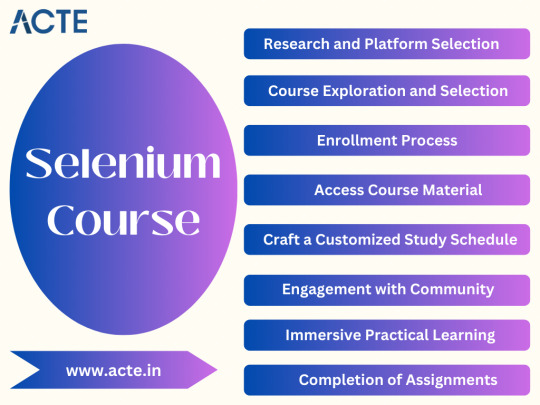
The Ultimate Course for Leveling Up Your Selenium Skills
Now that you understand the significance of Selenium in test automation, let's explore the ultimate course that can skyrocket your skills in this domain. This comprehensive course is designed by industry experts with extensive experience in test automation using Selenium. It covers everything from the fundamentals to advanced topics, ensuring a comprehensive and well-rounded learning experience.
Course Curriculum Highlights
Here's a glimpse of what you can expect to learn from this ultimate Selenium course:
Introduction to Selenium and its various components
Understanding Selenium WebDriver and its core functionalities
Hands-on exercises to master Selenium IDE and Selenium Grid
In-depth exploration of best practices for test automation using Selenium
Utilizing TestNG for efficient test case management and optimization
Advanced techniques for handling dynamic elements, AJAX, and other challenging scenarios
Integrating Selenium with frameworks like JUnit and Cucumber for improved test reporting and maintenance
Leveraging Selenium with Continuous Integration tools like Jenkins for seamless integration into the development pipeline
Exploring Selenium's compatibility with cloud platforms for distributed test execution
Target Audience and Prerequisites
Whether you are a beginner stepping into the world of test automation or a seasoned professional aiming to enhance your Selenium skills, this course caters to all skill levels. However, having a basic understanding of programming concepts and web technologies will be beneficial in grasping the core concepts effectively.
In conclusion, if you are looking to take your test automation skills to the next level, investing in the ultimate Selenium course at ACTE Technologies is the perfect choice. With Selenium's powerful capabilities and the comprehensive curriculum of this course, you will acquire the knowledge and expertise needed to excel in the field of test automation. So, why wait? Embark on this exciting journey and empower yourself with the skills that will set you apart in the competitive IT industry. Level up your Selenium skills and unlock endless opportunities!
8 notes
·
View notes
Text
What is Digital marketing and how can we earn from it?
According to me I can offer valuable insights into the field and lucrative earning opportunities. Digital marketing involves promoting products, services, or brands through various online channels, including websites, social media, search engines, email, and mobile apps. Here are some strategies and examples that are working well for freelancers in the digital marketing industry:
Content Creation and Marketing: Content remains king in digital marketing, and freelancers can capitalize on this by offering content creation services such as blog writing, article writing, video production, and infographic design. High-quality, engaging content helps businesses attract and retain customers while improving their search engine rankings.
Example: A freelance writer specializing in technology creates informative blog posts and whitepapers for software companies, helping them establish thought leadership in their industry and drive organic traffic to their website.
Search Engine Optimization (SEO): SEO is essential for businesses to improve their visibility in search engine results pages (SERPs) and drive organic traffic to their websites. Freelancers can offer SEO services such as keyword research, on-page optimization, link building, and SEO audits to help clients rank higher in search engine rankings.
Example: An SEO specialist helps a local bakery optimize its website for relevant keywords such as "best cakes in [city]," resulting in increased online visibility and more foot traffic to the bakery.
Social Media Management: Many businesses struggle to effectively manage their social media presence. Freelancers can offer social media management services, including content creation, posting schedules, community engagement, and paid advertising campaigns, to help clients grow their social media following and drive engagement.
Example: A freelance social media manager helps a small business owner create and curate engaging content for their Instagram account, increasing brand awareness and attracting new customers.
Email Marketing: Email marketing remains one of the most effective ways to nurture leads, promote products or services, and maintain customer relationships. Freelancers can offer email marketing services such as email campaign creation, list segmentation, A/B testing, and performance tracking to help clients generate leads and drive sales.
Example: An email marketing freelancer designs and implements a series of automated email campaigns for an e-commerce retailer, resulting in higher open rates, click-through rates, and conversions.
Pay-Per-Click (PPC) Advertising: PPC advertising allows businesses to reach their target audience through targeted ads on search engines and social media platforms. Freelancers can offer PPC management services, including keyword research, ad creation, bid management, and performance tracking, to help clients maximize their return on investment (ROI) from PPC campaigns.
Example: A freelance PPC specialist helps a startup company launch and optimize Google Ads campaigns, driving qualified traffic to their website and increasing sales leads.
Affiliate Marketing: Freelancers can participate in affiliate marketing programs to earn commissions by promoting products or services through their website, blog, or social media channels. By partnering with companies as affiliates, freelancers can monetize their online presence and audience.
Example: A freelance blogger writes product reviews and tutorials on their website and includes affiliate links to recommended products, earning commissions for every sale generated through their affiliate links.
Ready to take your digital marketing skills to the next level? Enroll now in our comprehensive free online masterclass and unlock the secrets to success in the ever-evolving world of digital marketing.
#digital marketing#masterclass#learn#online earning#affliate#freelance#career#career in digital marketing
2 notes
·
View notes
Text
SAP Basis

SAP Basis: The Backbone of Your SAP Landscape
SAP applications form the core of many modern enterprises. Financial data, customer interactions, supply chain logistics, and many other critical business operations rely on SAP’s robust solutions. But what powers these solutions? That’s where SAP Basis comes in.
What is SAP Basis?
In simple terms, SAP Basis is the technological foundation upon which SAP applications are built and run. It’s like the operating system specifically for your SAP world. Basis provides a set of middleware components and administration tools that ensure your SAP applications function smoothly and reliably.
Key Responsibilities of an SAP Basis Administrator
SAP Basis administrators are the unsung heroes of the SAP world, responsible for a wide range of tasks:
Installation and Configuration: Basis admins handle the initial installation and setup of SAP systems, ensuring they’re configured correctly for your business needs.
System Administration: They perform ongoing tasks like monitoring system health, applying patches and upgrades, and managing system resources.
Database Management: This includes database installation, configuration, backup and restore processes, and overall database health.
Performance Tuning: Basis admins identify bottlenecks, optimize settings, and ensure applications run at their peak.
User Management: Creating and managing user accounts, assigning roles and authorizations for secure access control.
Troubleshooting: When problems arise, these experts step up to diagnose and resolve issues promptly, minimizing downtime for the business.
Transport Management: They oversee the movement of code changes and configuration updates between different SAP environments (e.g., development, testing, production).
Components of SAP Basis
Some core components that make up SAP Basis include:
SAP NetWeaver: The core technology platform that provides the foundation for different SAP products.
ABAP Workbench: The development environment for creating custom ABAP code (SAP’s primary programming language).
SAP GUI: The graphical user interface used to interact with SAP systems.
Transport Management System: Tools for managing and tracking changes across SAP environments.
Solution Manager: A centralized platform for system monitoring, diagnostics, and support tools.
Why is SAP Basis Important?
Reliability and Stability: A well-managed SAP Basis system means your critical business applications will run smoothly, minimizing disruptions and downtime.
Performance: Basis expertise ensures that your SAP applications are optimized to deliver their best, promoting efficient business operations.
Security: Basis includes a suite of tools to manage user access, protect sensitive data, and ensure compliance with security standards.
Agility: A flexible Basis layer gives your business the ability to adapt to changing needs by scaling SAP deployments or introducing new components.
Becoming an SAP Basis Administrator
A career in SAP Basis is both challenging and rewarding. If you have a knack for technical troubleshooting, problem-solving, and enjoy working with complex systems, here’s how to get started:
Get a Technical Foundation: A background in computer science, database administration, or system administration is a strong starting point.
Gain SAP Expertise: Take SAP Basis training courses and explore online resources and tutorials.
Certifications: Consider getting SAP-certified in Basis administration to validate your skills.
Hands-on Experience: Look for internship or entry-level positions that allow you to work on real SAP systems.
The Future of SAP Basis
As SAP continues to evolve into a cloud-centric platform, Basis will adapt too. Knowledge of cloud technologies, containerization, and automation will become increasingly valuable for Basis administrators.
youtube
You can find more information about SAP BASIS in this SAP BASIS Link
Conclusion:
Unogeeks is the №1 IT Training Institute for SAP BASIS Training. Anyone Disagree? Please drop in a comment
You can check out our other latest blogs on SAP BASIS here — SAP BASIS Blogs
You can check out our Best In Class SAP BASIS Details here — SAP BASIS Training
Follow & Connect with us:
— — — — — — — — — — — -
For Training inquiries:
Call/Whatsapp: +91 73960 33555
Mail us at: [email protected]
Our Website ➜ https://unogeeks.com
Follow us:
Instagram: https://www.instagram.com/unogeeks
Facebook: https://www.facebook.com/UnogeeksSoftwareTrainingInstitute
Twitter: https://twitter.com/unogeek
2 notes
·
View notes
Text
Choosing Your Email Success: The Ultimate Guide to Selecting the Right Email Marketing Services
In the ever-evolving landscape of digital marketing, where communication is key, email marketing services have become a linchpin for businesses aiming to connect with their audience effectively. However, with a plethora of options available, selecting the right email marketing service can be a critical decision. This ultimate guide is designed to walk you through the essential considerations and steps to help you choose the perfect email marketing service for your business needs.

1. Define Your Email Marketing Goals
Clarify Your Objectives
Before delving into the selection process, articulate your email marketing goals. Whether it's nurturing leads, driving sales, or increasing brand awareness, having clear objectives will guide your choice of an email marketing service.
2. Assess Ease of Use and User Interface
Intuitive Platform
Choose an email marketing service with a user-friendly interface. A platform that is easy to navigate and offers a straightforward setup will save you time and ensure that you can maximize the features without a steep learning curve.
3. Email Templates and Design Flexibility
Customization Options
Evaluate the range of email templates offered by the service. It's essential to have templates that align with your brand aesthetics. Additionally, look for services that provide flexibility in design customization to create emails that resonate with your audience.
4. Contact Management and Segmentation
Efficient Contact Management
A robust email marketing service should offer efficient contact management capabilities. This includes easy segmentation options to target specific groups within your audience based on demographics, behaviours, or other criteria.
5. Automation and Workflow Capabilities
Time-Saving Automation
Automation features are integral to successful email marketing. Look for a service that allows you to set up automated workflows for tasks such as welcome emails, follow-ups, and personalized content delivery. Automation saves time and ensures timely communication.
6. Deliverability and Email Testing
Ensuring Inbox Placement
A high deliverability rate is crucial for successful email marketing. Choose a service that employs industry best practices to maximize the chances of your emails reaching your subscribers' inboxes. Additionally, look for features that allow you to test and preview emails before sending them out.
7. Analytics and Reporting Features
Data-Driven Insights
Comprehensive analytics tools are essential for gauging the success of your email campaigns. Look for a service that provides detailed reporting on metrics such as open rates, click-through rates, and conversion rates. Data-driven insights enable you to refine your strategies for better results.
8. Integration Capabilities
Seamless Integration
Consider the integration capabilities of the email marketing service with other tools and platforms you use, such as CRM systems, e-commerce platforms, or analytics tools. Seamless integration ensures a cohesive marketing ecosystem.
9. Scalability for Business Growth
Adapting to Expansion
Select an email marketing service that can scale with the growth of your business. This includes accommodating a growing subscriber list and providing advanced features as your email marketing needs evolve.
10. Compliance and Security
Ensuring Data Security
Prioritize email marketing services that adhere to data protection regulations and ensure the security of your subscribers' information. Compliance with laws such as GDPR and CAN-SPAM is crucial to maintain trust with your audience.
11. Customer Support and Resources
Accessible Support
Assess the level of customer support provided by the email marketing service. Ensure that there are accessible support channels, whether it's through live chat, email, or phone. Additionally, check for available resources such as tutorials and documentation.
12. Pricing Structure
Transparent Pricing
Understand the pricing structure of the email marketing service. Look for transparent pricing with no hidden fees. Consider your budget and ensure that the chosen service aligns with your financial requirements.
Conclusion
Choosing the right email marketing service is a pivotal decision that can significantly impact the effectiveness of your communication strategies. By considering factors such as ease of use, customization options, automation capabilities, and scalability, you can make an informed decision that aligns with your business goals. This ultimate guide serves as your compass in navigating the diverse landscape of email marketing services, empowering you to select a platform that streamlines your email marketing efforts and contributes to the overall success of your digital marketing initiatives.
2 notes
·
View notes
Text
Master Profitable Algorithmic Strategies with the Best Algo Trading Course at ICFM – Stock Market Institute

Learn Algorithmic Trading with ICFM’s Industry-Leading Algo Trading Course in India
In today’s tech-driven financial landscape, algorithmic trading has rapidly gained prominence among retail and institutional traders alike. With the power of automation and quantitative models, traders can now execute strategies with speed, accuracy, and discipline. For individuals interested in tapping into this high-potential domain, enrolling in a top-tier algo trading course is essential. ICFM – Stock Market Institute stands out as a leading institution offering a comprehensive and practical algo trading course that prepares traders to develop, test, and execute strategies using algorithms in real market environments.
Why Choose ICFM’s Algo Trading Course for Practical Algorithmic Training
The algo trading course at ICFM is designed specifically for Indian financial markets and customized to suit both beginners and intermediate-level traders. What makes ICFM’s program stand out is its hands-on, application-oriented approach, where students learn by doing. Unlike generic online tutorials, the algo trading course at ICFM delves deep into the actual tools, coding languages, and broker integrations needed to succeed in algorithmic trading. The institute leverages real-time data, simulations, and back-testing environments to ensure every student builds confidence in their strategies before going live.
What the Algo Trading Course Covers at ICFM – Stock Market Institute
ICFM’s algo trading course offers a complete roadmap that begins with the basics of algorithmic trading and progresses to advanced strategy creation. The course introduces students to the foundations of quantitative finance, market microstructure, and order types. It then moves on to programming essentials—particularly in Python, which is the most widely used language in algorithmic trading. Students learn how to work with data feeds, historical data analysis, and strategy logic development.
A key feature of the algo trading course is its focus on back-testing and optimization. Learners are trained to test their strategies using historical market data, tweak parameters for better performance, and avoid overfitting. They also explore API integration with popular broker terminals, enabling them to automate their strategies in a live trading environment. With the right mix of theory, coding, and practical market application, this algo trading course sets students on a professional trajectory.
Real-Time Practice and Market-Integrated Learning
At ICFM, the algo trading course is not just about learning how algorithms work but also about understanding how they interact with real markets. Students are guided through market simulations where their codes run in real-time environments to analyze tick-by-tick data. This invaluable exposure helps them understand latency issues, slippage, and the importance of execution logic in algorithmic trading. By integrating trading platforms, brokers, and data providers, ICFM ensures that students can deploy their strategies in NSE and BSE markets seamlessly.
Expert Faculty and Advanced Mentoring Support
The algo trading course at ICFM is conducted by seasoned professionals with expertise in trading, financial modeling, and quantitative analysis. These mentors bring years of industry experience and guide students beyond just the curriculum. Their insights into how institutional-level strategies are built and deployed provide learners with a deep edge. The instructors encourage interaction, discussion, and one-on-one mentoring throughout the algo trading course. Even after course completion, students have access to ICFM’s support ecosystem where they can ask questions, troubleshoot errors, and receive updates on market developments relevant to algo trading.
Flexible Learning Modes and Recognized Certification
To accommodate the diverse needs of working professionals, students, and traders, ICFM offers both classroom and online formats for the algo trading course. Learners can join sessions physically in Delhi or opt for remote learning with full access to live classes, recordings, and learning material. The flexibility of this model allows for a more personalized pace and style of learning. Upon successful completion of the algo trading course, students are awarded a certificate from ICFM – Stock Market Institute. This certification is well-regarded in the financial industry and adds weight to professional profiles for roles in trading, quant research, and financial analysis.
Success Stories and Career Pathways After the Algo Trading Course
Over the years, ICFM’s algo trading course has empowered hundreds of students to launch successful careers in trading and finance. Many have gone on to become independent algo traders, quant analysts, and strategy developers for proprietary trading firms. The course has also helped business professionals add automation to their investment routines and optimize performance. Testimonials frequently highlight the clarity of instruction, depth of the content, and real-world application as key reasons for their successful transition into the algo trading space. Whether someone is looking to scale their trading operations or enter the world of quant finance, this algo trading course provides a strong foundation.
Conclusion: Take the Smart Step Towards Automated Trading with ICFM’s Algo Trading Course
As financial markets become faster and more data-driven, traditional manual trading methods are gradually being replaced by algorithmic strategies. If you aspire to stay ahead in this rapidly evolving domain, the algo trading course by ICFM – Stock Market Institute is your ideal entry point. With expert-led training, cutting-edge tools, live market exposure, and continuous support, ICFM equips you to confidently navigate the world of algorithmic trading. Enroll today in India’s most comprehensive algo trading course and take control of your trading future with technology and precision.
Read more: https://www.icfmindia.com/blog/stock-market-courses-in-delhi-online-free-get-ahead-without-spending-a-rupee
Read more: https://www.openpr.com/news/4065877/shocking-air-india-crash-triggers-stock-market-panic-across
0 notes
Text
Affiliate Marketing Hacks: Top Earners' Secret to Maxing Out Their Earnings
Affiliate marketing has rapidly grown into a multi-billion-dollar industry, attracting entrepreneurs, influencers, and bloggers from all over the world. But while many people try their hand at it, only a fraction become top earners. What separates the elite from the rest? The answer lies in smart strategies, data-driven decisions, and consistent optimisation. In this article, we’ll uncover the most powerful Affiliate Marketing Hacks that top performers use to maximise their income.
Learning the Fundamentals First
It is essential to learn the basics before jumping into Affiliate Marketing Hacks. Affiliate marketing entails the promotion of other individuals' products and earning commissions on each sale that is made through your referral link. It is a performance-based structure, and that means your income is directly linked to your efforts and strategies.
Top earners know the foundation matters: choosing the right niche, finding reliable affiliate programs, and building a strong content platform (blog, YouTube channel, or email list). These basics are non-negotiable for long-term success.
Hack #1: Choose High-Converting, High-Commission Products
One of the most important Affiliate Marketing Hacks is choosing the right products. Don't pursue high commissions alone — pay attention to conversion rates as well. A product paying 50% commission is pointless if nobody is buying it.
Top earners study affiliate dashboards and data analytics to see what's already selling. They tend to also test various offers in real-time with A/B testing to discover the commission rate vs. conversion potential sweet spot.
Tip: Hunt for evergreen products or subscription services. These can earn you recurring monthly commissions, enabling you to create passive income streams.
Hack #2: Build an Email List Early
One of the most effective affiliate marketing tools is an email list. Social media algorithms and SEO may shift overnight, but your email list belongs to you.
One of the most underrated Affiliate Marketing Hacks is beginning email capture from day one. Utilise lead magnets such as free eBooks, discount codes, or video series to get them onto your list. Once they're on your list, give them value regularly and intermingle your affiliate promotions in there strategically.
Successful producers use email automation tools such as ConvertKit, ActiveCampaign, or GetResponse to create automated funnels that nurture leads and turn them into buyers, even if they are sleeping.
Hack #3: Build Honest, Value-Driven Content
Shoppers are smarter than ever. They can smell a hard sell from a mile away. Successful affiliate marketers employ value-driven content to establish trust with their audience.
Think reviews, tutorials, comparisons, and case studies. These types of content not only attract traffic but also educate the user, getting them to buy via your affiliate link.
One of the best affiliate marketing hacks is storytelling. Don't give product features — share with your readers how it worked for you. Real-life experiences sell better than any sales pitch.
Hack #4: Use SEO and Content Clustering
Having organic, free traffic from search engines is a fantasy for all affiliate marketers. Super affiliates optimise their websites through SEO and content clustering.
Content clustering means having a pillar page (for example, "Ultimate Guide to Fitness Supplements") and linking it with associated articles (for example, "Best Pre-Workout Supplements," "Top Whey Proteins"). This informs Google about the topic context and ranks better.
When using Affiliate Marketing Hacks, putting target terms such as "best," "top," and "review" in titles and descriptions will assist in boosting click-through rates and driving buyer-intent traffic.
Hack #5: Repurpose Content Across Multiple Platforms
Why stick to a single platform? Top performers get the most out of their content by repurposing it. A blog article can be a YouTube video, podcast episode, Instagram carousel, or LinkedIn article.
One of the smartest Affiliate Marketing Hacks is content syndication. Posting your content on Medium, Quora, and LinkedIn (with a nod of attribution) can increase your visibility and generate more traffic without producing brand-new content.
Hack #6: Monitor Everything and Optimise Like Crazy
The best affiliate marketers approach their work as a business. They monitor every click, conversion, and dollar made.
Use tools like Google Analytics, Pretty Links, and affiliate dashboards to monitor performance. Top earners constantly test different headlines, call-to-actions, link placements, and landing pages to improve conversion rates.
Among all Affiliate Marketing Hacks, the one that makes the biggest difference is data optimisation. If you’re not tracking, you’re guessing — and guessing is expensive.
Hack #7: Utilise Bonuses and Incentives
Want to turbocharge your conversions? Provide bonuses to individuals who purchase through your affiliate link. They can be digital products, special webinars, templates, or consultation calls.
High-earners utilise this tactic to add value on top of the product they're selling. It makes their offer more appealing and assists in overcoming buyer resistance.
This is one of the least appreciated Affiliate Marketing Hacks, but tremendously powerful in competitive markets.
Hack #8: Remain Ahead of Trends and Updates
Affiliate marketing is dynamic. Policies get modified by platforms, programs get upgraded, and consumer habits change. Being ahead of trends keeps you competitive.
High earners regularly attend webinars, listen to thought leaders, and join mastermind groups. They monitor new platforms such as TikTok, AI marketing software, or new affiliate programs with improved payout rates.
Adjusting in a hurry is not only a choice — it's a skill for survival and one of the wisest Affiliate Marketing Hacks to follow.
Hack #9: Building Authority
Trusting souls buy from people they trust. Rather than hawking everything available, profitable affiliates become authorities within one niche.
Establish your brand by being consistent, open, and content-driven. Authority brings loyalty, and loyal patrons convert.
This long-term thinking won't be the most sexy of Affiliate Marketing Hacks, but it's the one that promises sustainability and growth.
Final Thoughts
Affiliate marketing has unlimited potential, but it's competitive. By using these Affiliate Marketing Hacks, you place yourself miles ahead of occasional affiliates.
From. Selecting high-converting products to optimise with SEO, repurposing, establishing authority, and monitoring performance, every strategy puts you one step nearer to joining the list of high earners.
Consistency, honesty, and an openness to experiment and adjust are your best tools. Now that you have insider secrets, it's time to act and begin maximising your affiliate earnings today.
Ready to take affiliate marketing to the top? Begin implementing these Affiliate Marketing Hacks and turn your side hustle into a six-figure business.
#AffiliateMarketingHacks#AffiliateMarketing#MakeMoneyOnline#PassiveIncome#DigitalMarketing#MarketingTips#SEOTips#EmailMarketing#ConversionOptimization#SideHustle#WorkFromHome#ContentMarketing#OnlineBusiness#AffiliateTips#TrafficGeneration
1 note
·
View note
Text
Unlock Wealth with ICFM’s Best Algo Trading Course for You

In today’s fast-moving financial markets, technology plays a central role in maximizing trading efficiency, speed, and profitability. One of the most revolutionary advancements in the trading world is algorithmic trading, commonly known as algo trading. It allows traders to automate strategies and execute trades at lightning speed using pre-programmed instructions. If you want to stay competitive in the evolving landscape of stock trading, mastering algo trading is no longer optional—it’s essential. This is where the algo trading course offered exclusively by ICFM INDIA comes in.
ICFM INDIA is a trusted leader in stock market education, known for blending technical expertise with practical exposure. Their algo trading course is carefully designed to equip both aspiring and experienced traders with the skills required to thrive in an algorithm-driven market. Whether you are a trader, investor, finance student, or tech enthusiast, this course opens the door to limitless possibilities in automated trading.
What Is Algo Trading and Why Is It So Important Today?
Algo trading, or algorithmic trading, involves using computer programs and software to execute trades based on a defined set of instructions. These instructions are based on timing, price, quantity, or any mathematical model. Once programmed, algorithms execute trades without human intervention—removing emotion, increasing efficiency, and improving accuracy.
This method is widely used by institutional traders, hedge funds, and now increasingly by retail traders. Algorithms can analyze massive data sets in milliseconds, respond to market changes instantly, and carry out multiple orders simultaneously—something a human trader simply cannot match.
With automation becoming the future of stock trading, learning how to design, implement, and optimize trading algorithms gives you a competitive edge. The algo trading course by ICFM INDIA helps you do exactly that—making you not just a trader, but a tech-powered market strategist.
Why Choose ICFM INDIA for an Algo Trading Course?
While various platforms offer online resources on algo trading, what makes ICFM INDIA stand out is its industry-relevant, mentor-driven, and practice-based approach. The algo trading course at ICFM INDIA is structured to provide comprehensive knowledge, from basic algorithmic principles to advanced strategy development and live testing.
Unlike generic online tutorials, ICFM’s course is led by real market professionals who understand the intricacies of both trading and technology. Students don’t just learn theories—they build and test algorithms on live data, guided by experienced mentors who provide personalized feedback.
Moreover, ICFM INDIA offers live market exposure, helping students see how algorithms perform in real trading environments. This hands-on learning gives students the confidence and clarity they need to become independent algorithmic traders.
Course Structure and Learning Methodology
The algo trading course at ICFM INDIA is thoughtfully designed for learners from both trading and technical backgrounds. The course begins with an introduction to financial markets, trading platforms, and basics of coding (if required). Students learn about algorithmic architecture, market microstructure, backtesting techniques, and how to automate strategies using software tools.
The curriculum includes modules such as:
Basics of algorithmic trading and market mechanisms
Python programming for financial modeling
Building and backtesting strategies
Using APIs to connect with brokers
Risk management in automated systems
Live deployment of algorithms in real-time trading
ICFM ensures that even students with non-technical backgrounds are given support through foundational coding lessons and practical assignments. At every stage, theoretical knowledge is followed by practical implementation—so students don’t just learn about algo trading; they actually perform it.
Hands-On Learning: Build and Deploy Your Own Trading Bot
One of the highlights of ICFM INDIA’s algo trading course is that students get the chance to develop and deploy their own trading bots. This real-world project is not only exciting but also transformational.
By the end of the course, learners are able to write scripts that can scan the market, identify trade opportunities, place orders, manage risk, and exit trades—all automatically. This gives students the confidence to enter the market with a working algorithm and optimize it based on performance.
Students are also taught how to use backtesting tools, which simulate how an algorithm would have performed in the past. This allows traders to tweak and refine strategies before going live, minimizing risk and maximizing potential.
Who Should Enroll in the Algo Trading Course at ICFM INDIA?
ICFM INDIA’s algo trading course is ideal for a diverse range of learners:
Traders and investors looking to scale their operations with automation
IT professionals wanting to enter the financial domain
Engineering or finance students preparing for a career in fintech
Quantitative analysts aiming to refine their programming and market skills
Retail traders seeking to remove emotion and trade efficiently
No prior programming knowledge is mandatory, as the course begins from the basics and gradually progresses to advanced implementations. The only prerequisites are curiosity, commitment, and a passion for learning how trading works in the modern world.
Certification and Career Opportunities After the Course
Upon completion, students receive a certification from ICFM INDIA, validating their expertise in algorithmic trading. This certification is recognized by financial institutions and can enhance your profile when applying for jobs in trading firms, brokerage houses, or fintech companies.
Moreover, many students use the skills from the course to become full-time traders, develop their own bots, or even launch algorithm-based trading services. With technology rapidly reshaping the financial sector, the demand for algorithmic traders and quantitative analysts is growing exponentially—and this course places you at the center of that demand.
Why Algo Trading is the Future of Stock Market Participation
Speed, precision, scalability—these are the cornerstones of algo trading. As financial markets become increasingly data-driven and competitive, manual trading alone is no longer sufficient. Automated systems help remove emotion, reduce human error, and allow traders to participate 24/7 in global markets.
Moreover, algo trading empowers even small retail traders to compete with institutions by giving them access to the same tools and techniques. With the right training—like the one offered by ICFM INDIA—you can turn algorithms into powerful financial allies.
The ability to automate your trading not only increases profitability but also saves time and effort, allowing you to diversify your strategies and manage your capital more efficiently.
Conclusion: Enroll in ICFM INDIA’s Algo Trading Course and Revolutionize Your Trading Journey
The stock market is no longer ruled by gut feeling and manual decisions. In this data-driven era, algorithmic trading is the key to long-term success—and ICFM INDIA is your trusted partner in this transformation. Their expertly designed algo trading course empowers you with the technical knowledge, practical skills, and mentorship needed to excel in today’s automated markets.
Whether you are an aspiring trader, a finance student, or an IT professional looking to break into fintech, this course gives you the roadmap and tools to build and execute your own trading algorithms confidently.
Read more blogs - https://www.icfmindia.com/blog/free-vs-paid-stock-market-course-in-india-which-one-is-right-for-you
Read more blogs - https://www.openpr.com/news/4061256/boost-confidence-with-this-powerful-stock-market-course
Read more blogs - https://digideskindia-intern03.systeme.io/stock-market-classes
0 notes
Text
How to Learn Python for Beginners: Tips and Resources

Python has become one of the most popular programming languages in the world, known for its simplicity and versatility. Whether you are a complete novice or someone looking to expand your programming skills, learning Python can open up a world of opportunities in fields such as web development, data analysis, artificial intelligence, and more. This guide, "How to Learn Python for Beginners: Tips and Resources," aims to provide you with practical advice and valuable resources to kickstart your Python learning journey.
Understanding Python
Before diving into the learning process, it’s essential to understand what Python is and why it is so widely used. Python is an interpreted, high-level programming language that emphasizes code readability and simplicity. Its syntax is designed to be intuitive, making it an excellent choice for beginners. Python supports multiple programming paradigms, including procedural, object-oriented, and functional programming, which allows developers to choose the best approach for their projects.
Setting Up Your Environment
The first step in learning Python is to set up your development environment. Here’s how to get started:
Install Python: Download the latest version of Python from the official website (https://www.python.org/downloads/). The installation process is straightforward, and you can choose to install additional tools like pip, which is a package manager for Python.
Choose an Integrated Development Environment (IDE): An IDE is a software application that provides comprehensive facilities to programmers for software development. Popular IDEs for Python include:PyCharm: A powerful IDE specifically designed for Python development. Visual Studio Code: A lightweight and versatile code editor with excellent Python support. Jupyter Notebook: Ideal for data analysis and visualization, allowing you to create and share documents that contain live code.
Set Up a Virtual Environment: It’s a good practice to create a virtual environment for your Python projects. This allows you to manage dependencies and avoid conflicts between different projects. You can create a virtual environment using the following command:bashRunCopy code1python -m venv myenvActivate it with:On Windows: myenv\Scripts\activate On macOS/Linux: source myenv/bin/activate
Learning Resources
With your environment set up, it’s time to explore various resources to learn Python effectively. Here are some recommended resources:
Online Courses:Coursera: Offers courses like "Python for Everybody" by the University of Michigan, which is perfect for beginners. edX: Provides a range of Python courses from institutions like MIT and Harvard. Udemy: Features numerous Python courses, often at discounted prices, covering everything from basics to advanced topics.
Books:"Automate the Boring Stuff with Python" by Al Sweigart: A great book for beginners that focuses on practical applications of Python. "Python Crash Course" by Eric Matthes: A hands-on introduction to programming with Python, ideal for beginners. "Learn Python the Hard Way" by Zed A. Shaw: A popular book that emphasizes practice and repetition.
Interactive Platforms:Codecademy: Offers an interactive Python course that allows you to write code directly in your browser. LeetCode: A platform for practicing coding problems, which can help you improve your problem-solving skills in Python. HackerRank: Provides coding challenges and competitions to test your skills and learn from others.
YouTube Channels:Corey Schafer: Offers a series of Python tutorials that cover various topics in depth. Programming with Mosh: Provides beginner-friendly Python tutorials that are easy to follow. freeCodeCamp.org: Features comprehensive Python courses and tutorials for beginners.
Tips for Effective Learning
As you embark on your Python learning journey, consider the following tips to enhance your experience:
Practice Regularly: Consistency is key when learning a new programming language. Set aside time each day or week to practice coding. The more you code, the more comfortable you will become with Python.
Work on Projects: Apply what you learn by working on small projects. This could be anything from a simple calculator to a web scraper or a personal website. Projects help reinforce your knowledge and provide practical experience.
Join a Community: Engage with other learners and experienced developers by joining online communities such as Stack Overflow, Reddit (r/learnpython), or Python Discord servers. These platforms allow you to ask questions, share your progress, and learn from others.
Utilize Documentation: Familiarize yourself with the official Python documentation (https://docs.python.org/3/). It is a valuable resource that provides detailed information about Python’s features, libraries, and best practices.
Learn by Teaching: One of the best ways to solidify your understanding of a topic is to teach it to someone else. Consider writing blog posts, creating tutorials, or explaining concepts to friends or peers.
Stay Curious: Python is a vast language with numerous libraries and frameworks. Explore different areas such as web development (Django, Flask), data analysis (Pandas, NumPy), and machine learning (TensorFlow, scikit-learn) to find what interests you the most.
Conclusion
Learning Python can be an exciting and rewarding journey, especially for beginners. By setting up your environment, utilizing the right resources, and following effective learning strategies, you can build a strong foundation in Python programming. Remember that persistence and practice are essential to mastering any skill, so stay motivated and keep coding!
1 note
·
View note
Text
Deciding Between Selenium with Python and Selenium with Java: An In-Depth Comparison
In the domain of automated testing, Selenium emerges as a pivotal tool for ensuring the reliability and quality of web applications. When it comes to selecting the programming language to harness Selenium's capabilities, two prominent contenders often come into play: Python and Java. Both languages offer distinct advantages and considerations, making the decision between them crucial for any automation project.

In this blog post, we'll conduct a thorough comparison of Selenium with Python and Selenium with Java, exploring their unique strengths, use cases, and factors to consider. By the end, readers will have a clearer understanding of which option aligns best with their project requirements, team proficiencies, and organizational objectives.
Python with Selenium:
Python, celebrated for its simplicity and readability, has garnered significant traction within the automation testing community. Let's delve into some key benefits of leveraging Python with Selenium:
Simplicity and Readability: Python's hallmark characteristics include simplicity and readability. Its concise syntax enables developers to express ideas in fewer lines of code, resulting in scripts that are easier to comprehend and maintain. For testers, this translates to expedited development cycles and reduced overhead in managing test suites.
Extensive Ecosystem: Python boasts a vast ecosystem of libraries and frameworks that complement Selenium, augmenting its capabilities for test automation. Whether handling data manipulation, conducting API testing, or generating test reports, Python's rich library support caters to diverse automation needs. Furthermore, the active Python community ensures an abundance of resources, tutorials, and documentation to aid testers throughout the automation journey.
Rapid Prototyping: Python's dynamic nature lends itself well to rapid prototyping and iterative development. Testers can swiftly experiment with different approaches, adapt scripts on-the-go, and respond promptly to evolving requirements. This flexibility seamlessly aligns with agile development methodologies, empowering teams to deliver high-quality software with agility.
Integration Compatibility: Python's interoperability with other tools and technologies makes it an appealing choice for Selenium automation. Whether integrating with continuous integration (CI) pipelines, test reporting frameworks, or version control systems, Python's versatility ensures smooth interoperability, streamlining the testing workflow and bolstering overall efficiency.

Java with Selenium:
Java, renowned for its robustness and performance, has long been a cornerstone in enterprise software development. Here are some compelling reasons to consider Java for Selenium automation:
Robustness and Performance: Java's static typing and strong object-oriented principles contribute to the robustness and performance of Selenium test suites. Its compile-time error checking aids in identifying potential issues early in the development phase, resulting in more stable and reliable automation scripts. For large-scale enterprise projects with stringent quality requirements, Java's reliability is a significant asset.
Widespread Adoption: Java enjoys widespread adoption within the enterprise landscape, making it a natural choice for organizations with existing Java codebases or a Java-centric development environment. The abundance of Java expertise in the workforce, coupled with extensive community support and industry recognition, solidifies its status as a preferred language for Selenium automation in many corporate settings.
Mature Tooling: Java's mature ecosystem of testing tools and frameworks, including JUnit and TestNG, seamlessly integrate with Selenium to offer comprehensive test automation solutions. These frameworks furnish advanced features such as parameterized testing, parallel execution, and built-in reporting capabilities, empowering testers to design and execute sophisticated test suites effortlessly.
Enterprise Support: Java's popularity in enterprise environments translates to robust support from vendors, extensive documentation, and a plethora of third-party integrations. For organizations seeking enterprise-grade features, reliability, and scalability in their Selenium automation endeavors, Java's ecosystem and support infrastructure present a compelling value proposition.
Conclusion:
In summary, both Selenium with Python and Selenium with Java present compelling options for test automation, each with its unique strengths and considerations. Python excels in simplicity, rapid development, and a vast ecosystem, making it an ideal choice for agile teams and projects with evolving requirements. Conversely, Java offers robustness, performance, and widespread enterprise support, rendering it well-suited for large-scale enterprise applications with stringent quality standards.
Ultimately, the decision between Python and Java for Selenium automation hinges on various factors such as project prerequisites, team proficiencies, and organizational preferences. By meticulously evaluating these factors and weighing the pros and cons of each option, stakeholders can make informed decisions that align with their specific needs and aspirations. Whether opting for the simplicity of Python or the robustness of Java, Selenium remains an indispensable tool for driving quality and efficiency in web application testing.
2 notes
·
View notes
Text
6 Things to Keep in Mind to Find the Best CRM Systems for Small Businesses

In this competitive world, running a startup or small business is a real task. You need to juggle a lot of tasks at once, including sales, customer service, marketing, and inventory. That’s why you will need to find the best crm systems so you can change the way to manage your business. A good CRM helps you manage your customer interactions, follow up on leads, and stay organised. So that you can save on your operational time and can also boost your productivity.
But with so many CRM tools out there, how do you choose the best crm systems for your small business? In this guest blog, we will explore the six key things to keep in mind so you can find the right crms for your unique needs.
1. Easy to Use and Set Up
Simplicity is the key for every small business. You don’t want to spend weeks learning how to use a CRM or hire a dedicated IT person just to run it. So you should look for a CRM system that offers:
A user-friendly interface
Clear navigation
Simple onboarding or tutorials
If it takes more than a few hours to understand the basics, it may not be the right fit. Many crm platforms providers offer free trials, so you can also use them to see if you can easily understand how to use them and set them up.
2. Fits Your Business Needs
There is no best crm systems that fits every business. Some are focused on sales tracking, while others are better for customer service or marketing automation. So while you are choosing the CRM for your business, you should ask yourself:
What are your main goals? (e.g., tracking leads, managing customer data, automating emails)
Who will use it? (Just you, or a team?)
Do you need mobile access?
You can match your business needs with the features of customer relationship management crm so you can avoid paying extra. It means you can only for the feature that you want to use.
3. Affordable Pricing
Budget is always a concern for small businesses. Luckily, many CRM providers offer plans for smaller companies. Some even have free versions with limited features. It is perfect so that you can just start using the CRM system.
Here’s what to check to find the best crm systems:
Monthly cost per user
Hidden fees (like data migration or customer support)
Discounted yearly plans
You should always choose a customer relationship management system that fits your budget, but that also offers you the features that you actually need.
4. Customization Options
Every business is different. That’s why customisation is so important. Your CRM should let you:
Add custom fields
Create personalised sales pipelines
Set up task reminders that fit your workflow
If you are able to tailor your CRM system as per your business’s needs, then you can save hours of time and stay more organised.
5. Integration with Other Tools
Your CRMs should work well with other software you already use, like:
Email platforms (e.g., Gmail or Outlook)
Accounting tools (e.g., QuickBooks)
Marketing tools (e.g., Mailchimp)
Project management software
By integrating the best crm systems with your current tools, you can offer a smooth workflow to your team. They will not have to jump between apps or re-enter the same data.
6. Strong Customer Support
Things can go wrong. When they do, good customer support can make all the difference. So you should look for crm platforms that offer:
Live chat or phone support
Helpful tutorials and FAQs
Quick response times
Before you make any decision, you can also check online reviews to see what other users say about the company’s support. This gives you a good idea of what to expect if you run into problems.
Conclusion
Finally, when you are choosing the best crm systems for your small business then it doesn’t have to be overwhelming. You should focus on your business needs, budget and ease of use. So that you can offer an easier experience to your team instead of a complicated one.
Take the time to test a few CRM systems before committing. Use free trials, read reviews, and talk to other business owners. So that you can build stronger customer relationships, save time, and grow your business faster than ever before.
#customer relationship management system#crm platforms#customer relationship management crm#best crm systems#crms
0 notes